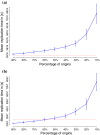A model for the spatiotemporal organization of DNA replication in Saccharomyces cerevisiae
- PMID: 19306105
- PMCID: PMC2695552
- DOI: 10.1007/s00438-009-0443-9
A model for the spatiotemporal organization of DNA replication in Saccharomyces cerevisiae
Abstract
DNA replication in eukaryotes is considered to proceed according to a precise program in which each chromosomal region is duplicated in a defined temporal order. However, recent studies reveal an intrinsic temporal disorder in the replication of yeast chromosome VI. Here we provide a model of the chromosomal duplication to study the temporal sequence of origin activation in budding yeast. The model comprises four parameters that influence the DNA replication system: the lengths of the chromosomes, the explicit chromosomal positions for all replication origins as well as their distinct initiation times and the replication fork migration rate. The designed model is able to reproduce the available experimental data in form of replication profiles. The dynamics of DNA replication was monitored during simulations of wild type and randomly perturbed replication conditions. Severe loss of origin function showed only little influence on the replication dynamics, so systematic deletions of origins (or loss of efficiency) were simulated to provide predictions to be tested experimentally. The simulations provide new insights into the complex system of DNA replication, showing that the system is robust to perturbation, and giving hints about the influence of a possible disordered firing.
Figures






Similar articles
-
The temporal program of chromosome replication: genomewide replication in clb5{Delta} Saccharomyces cerevisiae.Genetics. 2008 Dec;180(4):1833-47. doi: 10.1534/genetics.108.094359. Epub 2008 Oct 1. Genetics. 2008. PMID: 18832352 Free PMC article.
-
CLB5-dependent activation of late replication origins in S. cerevisiae.Mol Cell. 1998 Aug;2(2):173-82. doi: 10.1016/s1097-2765(00)80127-6. Mol Cell. 1998. PMID: 9734354
-
A variable fork rate affects timing of origin firing and S phase dynamics in Saccharomyces cerevisiae.J Biotechnol. 2013 Oct 20;168(2):174-84. doi: 10.1016/j.jbiotec.2013.06.022. Epub 2013 Jul 9. J Biotechnol. 2013. PMID: 23850861
-
The dynamics of chromosome replication in yeast.Curr Top Dev Biol. 2003;55:1-73. doi: 10.1016/s0070-2153(03)01001-9. Curr Top Dev Biol. 2003. PMID: 12959193 Review. No abstract available.
-
Surveying genome replication.Genome Biol. 2002;3(6):REVIEWS1016. doi: 10.1186/gb-2002-3-6-reviews1016. Epub 2002 May 24. Genome Biol. 2002. PMID: 12093380 Free PMC article. Review.
Cited by
-
Modeling inhomogeneous DNA replication kinetics.PLoS One. 2012;7(3):e32053. doi: 10.1371/journal.pone.0032053. Epub 2012 Mar 7. PLoS One. 2012. PMID: 22412853 Free PMC article.
-
Replication origins and timing of temporal replication in budding yeast: how to solve the conundrum?Curr Genomics. 2010 May;11(3):199-211. doi: 10.2174/138920210791110942. Curr Genomics. 2010. PMID: 21037857 Free PMC article.
-
Replication timing and its emergence from stochastic processes.Trends Genet. 2012 Aug;28(8):374-81. doi: 10.1016/j.tig.2012.03.011. Epub 2012 Apr 18. Trends Genet. 2012. PMID: 22520729 Free PMC article. Review.
-
What influences DNA replication rate in budding yeast?PLoS One. 2010 Apr 27;5(4):e10203. doi: 10.1371/journal.pone.0010203. PLoS One. 2010. PMID: 20436919 Free PMC article.
-
Mathematical modeling of genome replication.Phys Rev E Stat Nonlin Soft Matter Phys. 2012 Sep;86(3 Pt 1):031916. doi: 10.1103/PhysRevE.86.031916. Epub 2012 Sep 17. Phys Rev E Stat Nonlin Soft Matter Phys. 2012. PMID: 23030953 Free PMC article.
References
-
- {'text': '', 'ref_index': 1, 'ids': [{'type': 'DOI', 'value': '10.1128/MCB.00719-07', 'is_inner': False, 'url': 'https://doi.org/10.1128/mcb.00719-07'}, {'type': 'PMC', 'value': 'PMC2099622', 'is_inner': False, 'url': 'https://pmc.ncbi.nlm.nih.gov/articles/PMC2099622/'}, {'type': 'PubMed', 'value': '17636020', 'is_inner': True, 'url': 'https://pubmed.ncbi.nlm.nih.gov/17636020/'}]}
- Alvino GM, Collingwood D, Murphy JM, Delrow J, Brewer BJ, Raghuraman MK (2007) Replication in hydroxyurea: it’s a matter of time. Mol Cell Biol 27:6396–6406 - PMC - PubMed
-
- {'text': '', 'ref_index': 1, 'ids': [{'type': 'DOI', 'value': '10.1142/9781860949920_0009', 'is_inner': False, 'url': 'https://doi.org/10.1142/9781860949920_0009'}, {'type': 'PubMed', 'value': '18546477', 'is_inner': True, 'url': 'https://pubmed.ncbi.nlm.nih.gov/18546477/'}]}
- Barberis M, Klipp E (2007) Insights into the network controlling the G(1)/S transition in budding yeast. Genome Inform 18:85–99 - PubMed
-
- {'text': '', 'ref_index': 1, 'ids': [{'type': 'DOI', 'value': '10.1146/annurev.biochem.71.110601.135425', 'is_inner': False, 'url': 'https://doi.org/10.1146/annurev.biochem.71.110601.135425'}, {'type': 'PubMed', 'value': '12045100', 'is_inner': True, 'url': 'https://pubmed.ncbi.nlm.nih.gov/12045100/'}]}
- Bell SP, Dutta A (2002) DNA replication in eukaryotic cells. Annu Rev Biochem 71:333–374 - PubMed
-
- {'text': '', 'ref_index': 1, 'ids': [{'type': 'PubMed', 'value': '12851480', 'is_inner': True, 'url': 'https://pubmed.ncbi.nlm.nih.gov/12851480/'}]}
- Bielinsky AK (2003) Replication origins: why do we need so many? Cell Cycle 2:307–309 - PubMed
-
- {'text': '', 'ref_index': 1, 'ids': [{'type': 'DOI', 'value': '10.1038/nature07233', 'is_inner': False, 'url': 'https://doi.org/10.1038/nature07233'}, {'type': 'PubMed', 'value': '18716622', 'is_inner': True, 'url': 'https://pubmed.ncbi.nlm.nih.gov/18716622/'}]}
- Courbet S, Gay S, Arnoult N, Wronka G, Anglana G, Brison O, Debatisse M (2008) Replication fork movement sets chromatin loop size and origin choice in mammalian cells. Nature 455:557–560 - PubMed
Publication types
MeSH terms
Substances
LinkOut - more resources
Full Text Sources
Molecular Biology Databases

